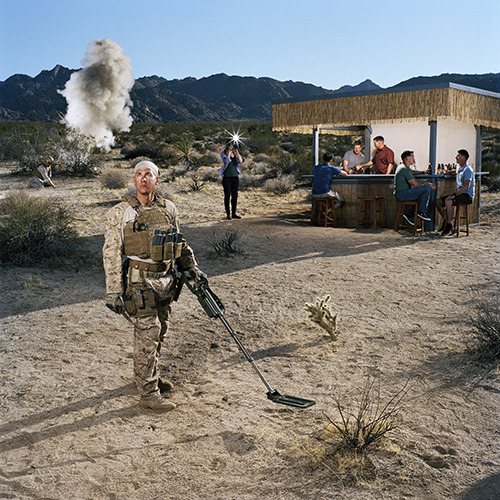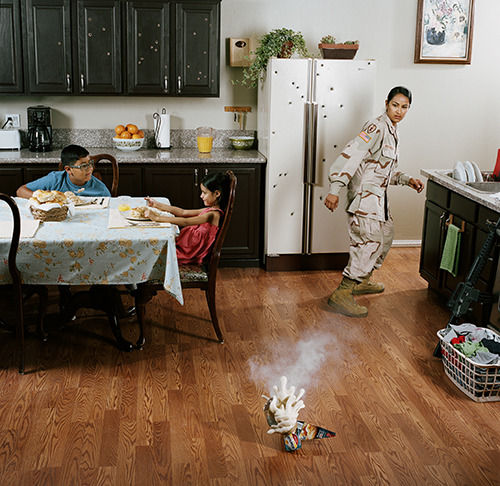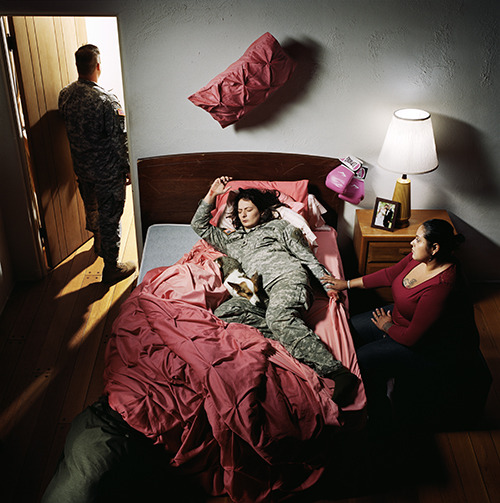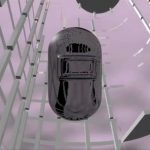Conversations | Jennifer Karady at MASS MoCA
“In my staged narrative photographs with veterans, the collision or collapse of the soldier’s world and the civilian world enables the viewer to glimpse a fragment of what is going on in the soldier’s mind. They evoke the psychology of life after war—how the past can infiltrate the present—and the challenges that adjustment to the home front entails.”
Artist Jennifer Karady directs the Fiscally Sponsored project “Soldiers’ Stories from Iraq and Afghanistan,” where she creates photographs with veterans through a collaborative process. NYFA Fiscal Sponsorship recently spoke with Karady, a trained lens-based artist, about the project’s evolution and its inclusion in the MASS MoCA exhibition Suffering from Realness. Join Karady at the exhibit’s reception on May 25, 2019, and catch the show through December 2019. Download a PDF of the exhibition guide here.
NYFA: How did you become interested in the lives of soldiers and why did you turn to them as photography subjects?
Jennifer Karady: When the U.S. invaded Iraq, I was looking for a way to connect with the wars in my work. In 2004, I read several news articles on combat stress that were related to a mental health study of Iraq and Afghanistan veterans in the New England Journal of Medicine. I found myself deeply moved by the accounts from individual veterans detailing how the intensity of their war experiences returned with them to the civilian world.
In my artistic practice, I have long sought to reveal invisible and often dark, unspoken truths about human nature and the human experience through meticulously constructed staged photography.
In my staged narrative photographs with veterans, the collision or collapse of the soldier’s world and the civilian world enables the viewer to glimpse a fragment of what is going on in the soldier’s mind. They evoke the psychology of life after war—how the past can infiltrate the present—and the challenges that adjustment to the home front entails. Each image is presented with text or audio of the story that inspired the photograph.

NYFA: Did you have preconceived notions of the military that were changed through your work on this project?
JK: When I began this project, I didn’t have any experience with the military. My understanding of war was instilled by my parents, who were children growing up in Europe and Eastern Europe during World War II—so mine is a civilian perspective. My year of research into the mental health issues that veterans face led me to initially seek stories about traditional combat, but as the work progressed, I found and chose to represent stories from veterans that challenged assumptions and expectations of what a war story is.
NYFA: When we viewed the images for the first time, we were surprised to learn that you don’t use Photoshop. Why is working with traditional photography techniques important to your practice?
JK: My subjects are actively engaged in the subjective interpretation of their stories. Even though the photograph is a meticulously choreographed and carefully planned scene, there is an experiential and performative aspect to the photo shoot. The veteran enacts a pose or action from their chosen memory, in uniform, within a safe space, often in their everyday environment, surrounded by family and friends. The fact that I cannot change anything later maintains the truthfulness of the staged moment and the authenticity of the veteran’s participation. To digitally alter the photographs would feel antithetical to my process of collaboration.

NYFA: The exhibition at Mass MoCA includes both photographs from “Soldiers’ Stories from Iraq and Afghanistan” as well as a documentary about your process. What spurred you to make a film?
JK: I wanted to give viewers insight into the multi-layered, careful process of making a photograph, which can take months, and how the process can be helpful. I consider my process part of the work itself, and illuminating this allows viewers an additional way to connect with the work. The film chronicles the trajectory of the artistic process of my collaboration with Army veteran Lucero Morales in Azusa, CA, to make a photograph—from initial interviews to Lucero’s reaction to the final photograph nine months later.
NYFA: How has working in this new medium influenced your practice and what is the next chapter of “Soldiers’ Stories?”
JK: Making the “Soldiers’ Stories” film emboldened me to pursue an ambitious new project where I am working with fragments of veterans’ stories to explore the language of trauma and patriotism. Soldier’s Stories from Iraq and Afghanistan: Dissonance, an immersive and experiential multi-channel video and sound installation, will reveal the disconnect between the public visual display of patriotism on the Fourth of July and the way that soldiers often privately experience this holiday—how seemingly innocent displays of patriotism can be imbued with violence and memory.

NYFA: How has fiscal sponsorship impacted your work?
JK: The Fiscal Sponsorship team at NYFA has been instrumental in the forward momentum of my work. Last year, they encouraged me to apply for a 2019 grant from the New York State Council for the Arts (NYSCA) for Soldier’s Stories from Iraq and Afghanistan: Dissonance, a project I had been thinking about for a long time. When I did not think that I would be able to put together a competitive application within the time allotted, the team at NYFA offered persistent encouragement, guidance, feedback, and generosity. As a result, I earned important, early support for the production phase of this newly developed, multi-media installation. It is invaluable to feel that a professional arts organization is invested in my growth as an artist.
Are you an artist or a new organization interested in expanding your fundraising capacity through NYFA Fiscal Sponsorship? We accept out-of-cycle reviews year-round. No-fee applications are accepted on a quarterly basis, and our next deadline is June 30. Click here to learn more about the program and to apply. Sign up for our free bi-weekly newsletter, NYFA News, for the latest updates and news about Sponsored Projects and Emerging Organizations.
Images: Former Specialist Brittny Gillespie, 139th Military Police Company, 16th MP Brigade, U.S. Army, veteran of Operation Iraqi Freedom, with Volunteers of America Los Angeles Battle Buddy Elizabeth Saucedo and friend Corey, Los Angeles, CA, 2014, Chromogenic color print; Staff Sergeant Kyle Winjum, Explosive Ordnance Disposal Technician, U.S. Marine Corps, veteran of Operation Enduring Freedom and Operation Iraqi Freedom, with fellow Marines; Twentynine Palms, CA, 2014, Chromogenic color print; Former Specialist Lucero Morales, 25th Transportation Company, 25th Infantry Division, U.S. Army, veteran of Operation Iraqi Freedom, with children Emma and Nicolas, Azusa, CA, 2015, Chromogenic color print; and Former Lance Corporal West Chase, U.S. Marine Corps, Combat Service Support Company 113, I Marine Expeditionary Force, veteran of Operation Iraqi Freedom and Operation Enduring Freedom, with fiancée, Emily Peden; Ann Arbor, MI, 2014, Chromogenic color print. All Images from “Soldiers’ Stories from Iraq and Afghanistan,” Credit: Jennifer Karady.





